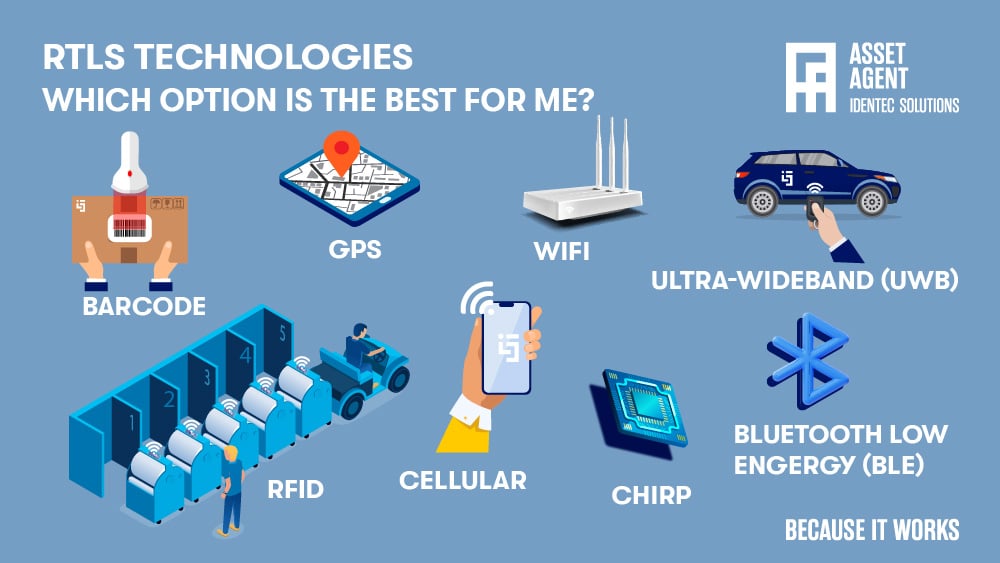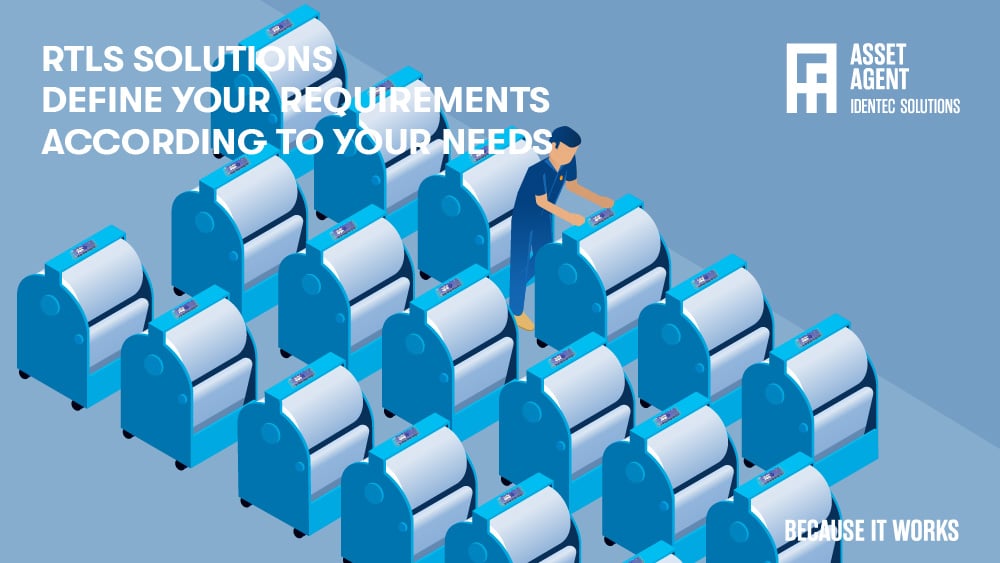RTLS TAGS and factory efficiency
| Written by Christian Aadal
If you're looking to increase efficiency in your manufacturing processes, you may be considering an RTLS (Real Time Locating System). But before making a decision on which system to choose, there are a few things you need to consider.
In our latest whitepaper, we'll walk you through some questions to ask yourself about your manufacturing process and environment. By answering these questions, you'll be better equipped to select the RTLS solution that best fits your needs.

No video selected
Select a video type in the sidebar.
Table of contents:
- Production processes and RTLS
- Which requirements do I have to consider for RTLS?
- What options do I have for RTLS?
- How to choose the best option for your needs?
- Takeaway
- Glossary
Production processes and RTLS
Today there are a lot of buzzwords in the world of increasing efficiency in manufacturing environments, such as IIoT, Industry 4.0, Industry 5.0, etc. However, they have in common that each term refers to industrial changes where technology and smart automation are utilized to improve processes and manufacturing patterns.
Do you want to understand RTLS technology? Download our RTLS eBook, no registration needed!
RTLS (Real Time Locating System) is one of the technologies which can be used for precisely this.
There are several things to consider when you are in the selection stage of an RTLS solution. One of the first things that need to be done is to look at your manufacturing processes and environment and ask yourself some questions such as:
- Is the vendor of the system familiar with my production processes?
- What type of items/assets am I trying to locate?
- Have I already pictured what a digital landscape could look like?
- How many items/assets does the system have to manage?
- Am I only looking at tracking items/assets, or do I also want state information?
- Do I already have transport orders in a digitized format?
The recommendation is always to use a vendor that is capable of guiding you through and speaks the ‘industrial language’ to help answer questions like the ones above and are able to propose the best possible RTLS solution for your needs and how it can fit into your existing manufacturing processes.
Which requirements do I have to consider for RTLS?
The most usual reason an RTLS solution doesn’t work as expected is that requirements have not been adequately communicated by the customer or are not correctly understood by the vendor. It is therefore always essential that the system requirements are well thought through.
Let me provide an example:
A car manufacturer wants an RTLS solution to manage and locate cars in their parking areas at the production facility. In the RFI (Request for Information) letter to the potential vendor, it is specified that the system needs accuracy of 10cm +/- 2cm, which is within the specification of what the vendor can provide. Next, a site survey is carried out, and the project rollout starts. Finally, after commissioning and site acceptance, it goes into production, and everything is fine, except for one thing… Why did they pay so much for a system that provides 10cm +/- 2cm accuracy when they actually needed a system that would tell them which parking slot each vehicle is parked in?
The chosen RTLS solution should always be within the expected requirements, as long as the requirements are realistically defined according to the needs.
Below is a list of questions you can ask yourself to avoid unrealistic requirements.
- Am I trying to locate items/assets over long or short distances?
- Is it indoor or outdoor?
- Is there a high metallic density in the area that should be covered?
- What level of accuracy do I expect?
- What are the sizes of the assets I am trying to locate?
- Will the size of the suggested tag/transponder fit?
- Battery lifetime?
- Do I want the data to be shared with a 3rd party application?
- Do I need a scalable solution for future needs?
- What is the update rate of each item/asset to monitor?

What options do I have for RTLS?
There is a big world of various RTLS solutions, with differences between technologies, accuracy, area of usage, range and scalability. To be able to choose the right RTLS solution for your needs, it all depends on the plans for end usage.
With the answers to the questions in chapters 1 and 2, you should be able to navigate the matrix below to see which RTLS solution initially would suit your needs the best.
| Accuracy | Area of usage | Scalability | Range | Summary | |
| Barcode | Manual scanning location | Indoor/outdoor | Very scalable | Very short | Effective for manual identification, but no possibility for automatic localization |
| RFID | Last 'scan' accuracy | Indoor/outdoor | Very scalable | Up to 500m | Effective for asset detection, but not for automatic localization |
| UWB | ~10cm - 1m | Indoor/outdoor | Very scalable | Up to 100m | Effective for precise asset localization |
| BLE | ~2m - 3m | Mainly indoor | Limited | Up to 100m | Effective for zone-based asset localization |
| WiFi | ~3m | Indoor/outdoor | Very scalable | Up to 50m | Effective for zone-based asset localization in small scale |
| Chirp | ~50cm - 1,5m | Indoor/outdoor | Very scalable | Up to 300m | Effective for precise asset localization in harsh environments |
| Cellular | ~30m - 100m | Outdoor | Scalable | Approx 35km | Effective for tracking large assets outdoors |
| GPS | ~7m - 10m | Outdoor | Scalable | Satellite dependency | Effective for tracking large assets outdoors |
*Barcode and RFID are not necessarily considered as RTLS solutions but is in the list to be used as references

How to choose the best option for your needs?
In addition to examining how the different RTLS solutions perform, there are other elements to consider with each solution. As with everything else in life, there are pros and cons to each solution. These differences could include price, form factor, ease of installation…
Below is a list of advantages and disadvantages for each solution that will guide you on choosing the right solution for your need
Barcode
Advantages:
- Inexpensive
- Small and lightweight
- Can be used to account for massive numbers of assets with no theoretical limit on the quantity
- Barcode scanners are typically much more affordable than RFID scanners
Disadvantages:
- Requires manual scanning and searching
- Scanning requires line-of-sight and often very short-range
- Dependent on data from the last point-of-scan; does not show real-time status or location
- Prone to human error like missed and erroneous scans
- Often requires expensive software components for inventory management
RFID
Advantages:
- Device longevity
- Small form factor
- Various low-cost options for tags
- Good airtime
Disadvantages:
- Variability of precision
- High cost of readers
- Complex system installations, sometimes requiring manual scans
- Wireless signals are often easy to intercept
- No true locational data
Ultra-wideband (UWB)
Advantages:
- Real-time updates
- Non-interference with most other RF signals and devices
- Unique radio signatures
- Enables top location accuracy
Disadvantages:
- Prone to signal interference in metallic environments
- Less mature standards and protocols for interoperability
- General reliance on time-syncing for location and tracking
- Less market acceptance/recognition
- Often requires more power than other wireless tracking technologies
Bluetooth Low EnerGy (BLE)
Advantages:
- Low power consumption
- Relatively inexpensive devices
- Accurate up to a few meters
- Real-time updates
- Wide standardization
- Cross-functionality with common consumer devices
Disadvantages:
- Latency
- Risk of interference from devices in the shared frequency spectrum
- Requires a high density of transmitters
- Inaccuracy in reflective or highly active environments like factories or refineries
- Security vulnerabilities
WiFi
Advantages:
- High data throughput
- Large range for localized wireless transmissions
- Potential to work in concert with many different WiFi-enabled devices
- Potential operability with existing WiFi networks, lowering installation costs
- Real-time updates
- WiFi standardization simplifies development and interoperability
Disadvantages:
- Lack of scalability
- Inaccuracy
- High power consumption
- Congestion of existing WiFi networks
- Some ongoing security risks
Chirp
Advantages:
- Reliable accuracy in high metallic and harsh environments
- High data throughput
- Large range for localized wireless transmissions
- Real-time updates
- Works standalone – without ETH connection to the anchors
Disadvantages:
- Less mature standards and protocols for interoperability
- Not widely known in the market
- Not optimal for smaller assets, like PCB’s or chips
Cellular
Advantages:
- Long range
- Near global reach
- Wide standardization
Disadvantages:
- Very high power requirements
- Risk of dead spots in obscure signal areas
- End-users rely on a third party for coverage
- Limited use in indoor or underground locations
- Low tracking accuracy
GPS
Advantages:
- Worldwide visibility for tracked assets (As of July 3, 2023, the Global Positioning System constellation comprises 31 operational satellites. The system requires a minimum of 24 satellites to provide global coverage, but the additional satellites enhance accuracy and reliability. (2))
- Near-global availability of satellite signals
- Large library of stable GPS tracking applications
- GPS integration into many professional and consumer devices
Disadvantages:
- High power consumption
- Requires line-of-sight with satellites/limitations in urban and indoor settings
- End-users cannot repair or adjust the space or control segments
Read on and learn about auto identification technology...
TAKEAWAY
Implementing RTLS in your production line is a sustainable and beneficial way to improve your process efficiency and factory productivity (read more in our success story about car logistics at Volkswagen Wolfsburg). It works with brownfield factories retrofitting production lines to industry 4.0 standards as well as with greenfield projects for cost-efficient investment. However, as RTLS can be achieved with many different technologies, each project is individual due to its economic, construction and production-related context. This said, different technologies show specific advantages and disadvantages. Therefore, implementing RTLS in a production line means first and foremost selecting the right technology.
Read on to learn more about the challenges of digital transformation for manufacturing.
Learn all about real time location systems in manufacturing and indoor logistics
Glossary
WiFi (Wireless Fidelity) is a wireless networking technology that enables devices to connect to the internet and communicate without physical cables. It operates on radio frequency bands (2.4 GHz, 5 GHz, and 6 GHz) using IEEE 802.11 standards. WiFi is widely used in homes, businesses, and public spaces for seamless connectivity. Advancements like WiFi 6 improve speed, efficiency, and security for modern digital applications.
References:
(1) Bendavid Y, Rostampour S, Berrabah Y, Bagheri N, Safkhani M. The Rise of Passive RFID RTLS Solutions in Industry 5.0. Sensors. 2024; 24(5):1711. https://doi.org/10.3390/s24051711
(2) https://www.gps.gov/systems/gps/space/
(3) Gast, M. (2016). 802.11 Wireless Networks: The Definitive Guide (2nd ed.). O'Reilly Media.
Note: This article was updated on the 11th of August 2025. This article was partly created with the assistance of artificial intelligence to support drafting. T

Author
Christian Aadal, Product Manager
Christian Aadal holds a degree in Information & Communications Technology and Media and has several years of experience in the Telecom industry, working for some of the top names in the business. From a technical support engineer to project engineer, Global Product Manager - Asset Agent to sales, Christian prides himself on being able to understand industry needs with a focus on optimization, digitalization and security. His experience in the field gives him the ability to provide solutions for customers that can best meet their requirements and generate the value they are looking for. His passion is around Industry 5.0, where humans can bring out max efficiency in machines, and machines can bring out max efficiency of humans.



